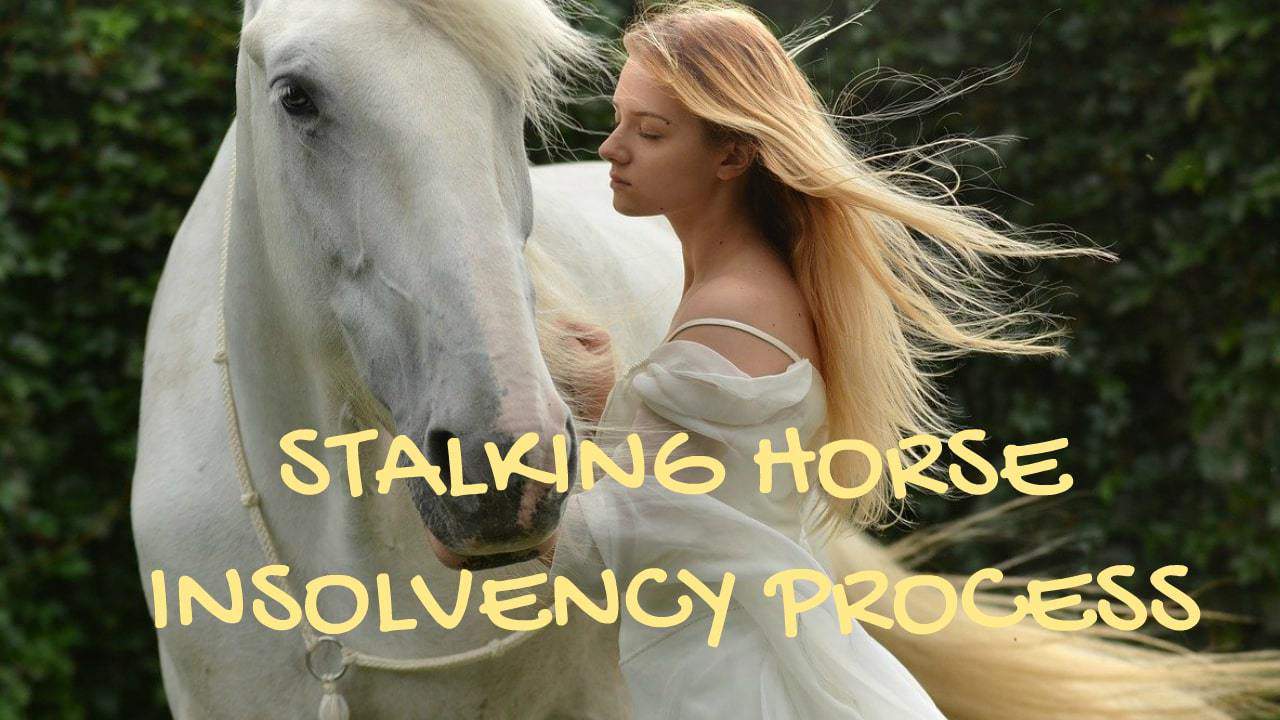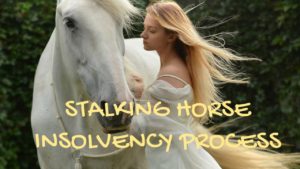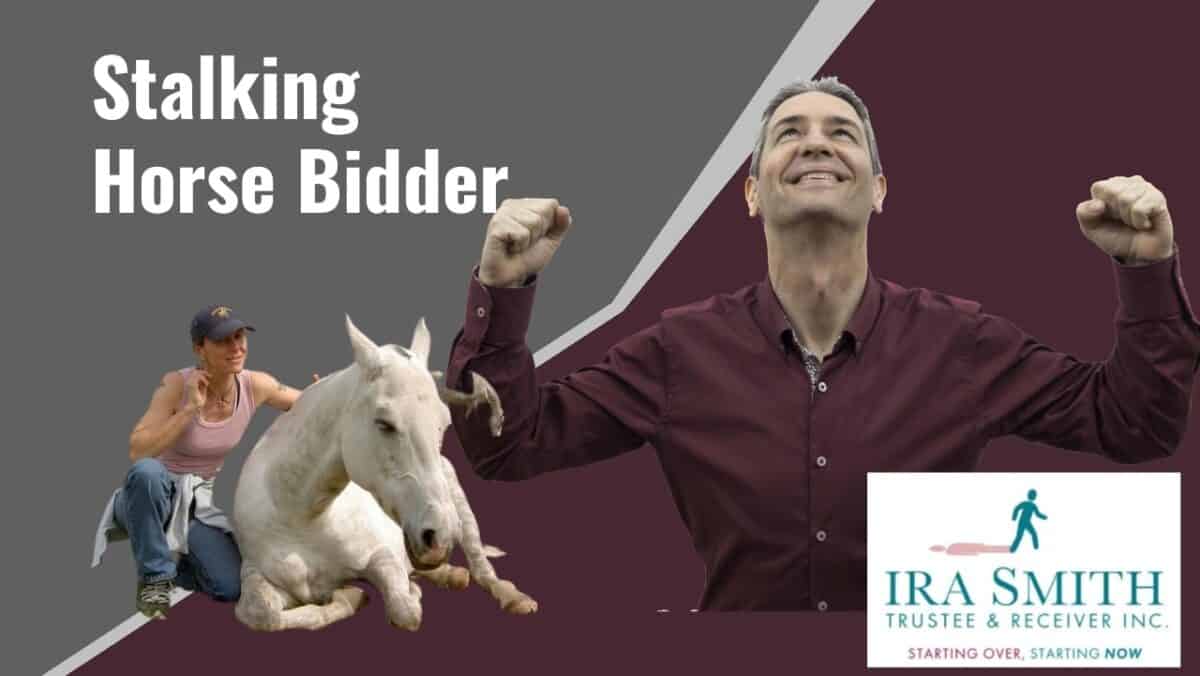Stalking Horse Offer Introduction
In Brandon’s Blog post, I provide an in-depth analysis of the stalking horse offer in the context of bankruptcy protection, drawing insights from a recent ruling by the Alberta Court in the case of Tool Shed Brewing. By examining the various elements that influence court decisions regarding such offers and the intricacies of managing a stalking horse sales process, I aim to shed light on this complex legal subject.
Through an examination of Tool Shed Brewing’s situation and an ongoing stalking horse case of mine, this article offers readers a comprehensive understanding of the challenges, nuances, and legal aspects involved in navigating the complexities of bankruptcy protection.
What is a Stalking Horse Offer?
Definition and Purpose of a Stalking Horse Offer
In an insolvency or bankruptcy proceeding, a stalking horse offer serves as an initial bid on the assets of a distressed company.
This offer sets a floor price for the assets, exposed to a public marketing process, and encourages other potential buyers to submit higher bids. The company typically chooses the stalking horse bidder in financial distress and plays a crucial role in the solicitation and investment solicitation process (SISP).
Benefits of a Stalking Horse Offer
By providing a baseline offer, the stalking horse offer aims to maximize the value of the company’s assets and streamline the sale process. Understanding the nuances of stalking horse offers is essential for companies navigating bankruptcy protection cases to secure the best possible outcome.

Stalking Horse Offer: Understanding the Stalking Horse Bid Process
How a Stalking Horse Bidder is Selected
In the business world, a stalking horse bidder is often used in the context of mergers and acquisitions or an insolvency or bankruptcy process to help facilitate the sale of a company (M&A) or the company’s assets (insolvency/bankruptcy process). The party selected to make the stalking horse offer is selected by the target company’s management team to submit an initial offer for the company or its assets, to start the bidding process.
The selection of a stalking horse bidder is a strategic decision, often based on their financial stability and expertise in the industry. Many times in an insolvency process, the stalking horse bidder may already be a stakeholder of the insolvent company. It is not unusual for a secured creditor, a major investor or a group affiliated with current management to make the stalking horse offer.
The stalking horse bidder serves as a starting point for other interested parties to make their bids, hopefully driving up the value of the company or its assets and maximizing the potential sale price. Careful consideration and due diligence are taken in selecting a stalking horse bidder to ensure the best outcome for all parties involved.
Factors Considered in Choosing a Stalking Horse Bidder
When considering a stalking horse bidder, several factors must be carefully evaluated to make an informed decision. The first and most crucial factor is the bidder’s financial stability and ability to fulfill their obligations. This includes their credit rating, cash flow, and previous track record in similar transactions. Additionally, the bidder’s strategic fit with the company and their long-term goals must be taken into account.
Other important factors include their experience in the industry, their proposed purchase price, and any proposed contingencies or conditions. It is also important to thoroughly review the bidder’s proposed plans for the company or the assets post-acquisition. By carefully considering all of these factors, it ensures that the right party has been chosen to make the stalking horse offer which is not only financially capable but also aligned with achieving the goals of the stalking horse sales process.
Importance of a Stalking Horse Bid in Attracting Other Bidders
A stalking horse bid plays a crucial role in attracting other bidders in a competitive bidding process. It is a preliminary bid made by a buyer to set a minimum price for the assets being sold. This bid serves as a starting point for other potential buyers to make their offers, creating a competitive environment.
A stalking horse bid also demonstrates the seriousness and commitment of the buyer, making it more likely for other bidders to take the opportunity seriously. Moreover, it provides a benchmark for fair market value, ensuring that the insolvency process results in the estate receiving the best possible price for the assets under the circumstances. In summary, a stalking horse bid catalyzes a successful and competitive bidding process.
In setting the floor price, the licensed insolvency trustee needs to be able to justify that price, amongst all the other details of the stalking horse offer. The use of appraisals will help the Trustee in justifying the stalking horse offer price as well as the ultimate sales price when seeking the approval of the court for both the SISP and the ultimate sale.
Stalking Horse Offer: Stalking Horse Bid Agreement
Contents and Terms of a Stalking Horse Bid Agreement
A stalking horse bid agreement is a legal document that outlines the terms and conditions of a potential acquisition or sale of a company’s assets. The contents of a stalking horse bid agreement include a detailed description of the assets being sold, the purchase price, and any conditions or contingencies that must be met for the sale to be completed. It also outlines the responsibilities and obligations of both the buyer and the seller. Additionally, the agreement may include confidentiality and non-disclosure terms to protect sensitive information. This agreement serves as a framework for the bidding and negotiation process, providing structure and protection for all parties involved.
In a court-appointed receivership I am involved in right now, we are using the stalking horse offer process in the court-approved SISP. The agreement we obtained court approval for is in a typical format used in insolvency or bankruptcy proceedings to facilitate the sale of a distressed company’s assets.
To give you a better idea of the content and terms in a stalking horse bid agreement, the main headings in the stalking horse offer asset purchase agreement we developed with our legal counsel are:
ASSETS TO BE SOLD AND PURCHASED
- Assumed Liabilities
- Assignments Requiring Consent
- Purchase Price
- Allocation of
- Purchase Price
- Bid and Auction Procedures
REPRESENTATIONS AND WARRANTIES
- Receiver’s Representations and Warranties
- Purchaser’s Representations and Warranties
- “As Is, Where Is”
COVENANTS
- Covenants of the Receiver
- Covenants of the Purchaser
CONDITIONS AND TERMINATION
- Conditions for the Benefit of the Purchaser
- Conditions for the Benefit of the Receiver
- Waiver of Condition
- Termination
- Effect of Termination
CLOSING ARRANGEMENTS
- Closing
- Receiver’s Closing Deliveries
- Purchaser’s Closing Deliveries
- Confidentiality
- Delivery of Receiver’s Certificate
COMPETING BIDS AND SALES PROCESS
- The Sale Process
- Break Fee

Stalking Horse Offer: Agreement for Expense Reimbursement and Breakup Fee
In a stalking horse offer, the seller may agree to cover certain expenses incurred by the stalking horse purchaser during the negotiation process. The seller always offers a breakup fee if the party making the stalking horse offer turns out not to be the buyer because the SISP produces a better offer.
This agreement for expense reimbursements and breakup fees, which are also called topping fees, is a common practice in the world of mergers and acquisitions and insolvency/bankruptcy process stalking horse sales, as it protects both parties involved. The potential buyer can gain a competitive advantage by being the first to make an offer while being compensated for incurring the time and expense of doing its due diligence and exposing its offer to the marketplace if the deal does not go through.
This type of agreement is typically negotiated carefully and is an important aspect of the overall SISP.
Stalking Horse Offer: The Importance of a Court-Approved Stalking Horse Agreement
A Court-Approved Stalking Horse Agreement and a Court-Approved SISP, are crucial tools in the process of a bankruptcy sale. The agreement allows a potential buyer, known as the “stalking horse,” to set a floor purchase price for the assets being sold. This not only ensures a fair and transparent bidding process but also provides a level of protection for the debtor’s estate. By setting a minimum bid, the stalking horse agreement prevents lowball offers and encourages competitive bidding, ultimately maximizing the value of the assets for the benefit of creditors. Furthermore, obtaining bankruptcy court approval for this agreement enhances the validity and credibility of the SISP.
Therefore, a Court-Approved Stalking Horse Agreement and SISP are of utmost importance in facilitating a successful bankruptcy sale.
Stalking Horse Offer: The Auction Process and Other Bidders
In the court-appointed receivership SISP I am running, using this sales process resulted in competition among bidders. We ended up having two Qualified Bidders (as defined in the SISP documents); the stalking horse bidder and one of the other parties who made an offer. Following the terms of the SISP bidding procedures, both Qualified Bidders were given the limited time allowed for in the sales process to advise if they wished to participate in an auction process. Both Qualified Bidders advised they would participate.
I held the auction on the day and time stated in the SISP documents. The result was that the price got bid up to a point where the stalking horse bidder dropped out of the auction.
As I am in court tomorrow seeking approval of a sale to the other bidder and not the stalking horse transaction, I can’t provide any specific details in this blog. What I can say is:
- This buyer originally made a low-ball offer before we were in a position to offer the assets for sale
- . For many reasons, the offer was rejected.
- The stalking horse offer price is 2.75 times the offer we rejected. The price achieved through the auction process is 1.5 times the stalking horse bid price.
The details contained herein and in our court material prove that the stalking horse sales process worked well in this case.
Stalking Horse Offer: Introduction to Tool Shed Brewing Company Inc.
Now let me take you on a journey through another real-life case through the fascinating world of Tool Shed Brewing Company Inc. (Tool Shed). This company ran a craft beer brewery and a restaurant.
Tool Shed had financial struggles that ultimately led to its bankruptcy protection filing. Despite their creative endeavours in the craft beer industry, Tool Shed found themselves grappling with substantial debts and financial obligations.
Tool Shed’s operations revolve around the production and distribution of both alcoholic and non-alcoholic beverages to various retailers and restaurants. The valuable assets were non-assignable licenses and permits issued by the Alberta Gaming, Liquor and Cannabis Commission. Tool Shed considered these assets as the pillars of their business.

Stalking Horse Offer: The Bankruptcy Protection Filing Through A Notice of Intention To Make A Proposal
In January 2024 the CRA took legal action against Tool Shed, highlighting the pressing financial crisis. Faced with the stark reality of its financial obligations, Tool Shed took a decisive step by filing a Notice of Intention To Make A Proposal under the Bankruptcy and Insolvency Act (Canada) (BIA), appointing a licensed insolvency trustee as their proposal trustee.
With the weight of financial distress looming over them, Tool Shed sought avenues for recovery, leading to the approval of a stalking horse bid by 2582568 Alberta Inc., a company owned by Tool Shed’s CEO, James Costello. However, this move faced opposition from individual investors and secured creditors, John Donovan and Juliana Bourne, who presented a competing bid through 2594617 Alberta Ltd.
February 12, 2024, played a crucial role in setting the stage for the ensuing developments. Tool Shed went to the Alberta court seeking an order not only to extend the timeline for filing a proposal but also for the approval of the interim financing by the Costello Company, and initiating the sales process, including the approval of the 2582568 Alberta Inc. offer. Despite the objections of the Donovan group, the court approved the relief requested by Tool Shed, including the SISP and the Costello offer approval.
The Stalking Horse Bid and Approval Application
The proposal trustee ran the SISP and then applied to court As the narrative unfolded, intense deliberations ensued, as Tool Shed faced the impending threat of bankruptcy. The contentious discussions revolving around the SISP transaction application brought to the fore the divergent viewpoints of stakeholders, including the Donovan Group and the Costello Company.
The Donovan Group raised many issues in opposing the approval of the sale to the Costello Company. There were also many issues affecting the court process, some of which were outside of the control of the stakeholders.
The road to approval is rarely smooth, and Tool Shed’s case is no exception. With opposing voices from the Donovan Group, who also were investors in Tool Shed, the Approval Application process became a battleground of conflicting interests.
As the clock ticked towards the crucial hearing date, scheduling issues and the need for more time loomed large. The delicate dance of legal procedures and the strategic moves of involved parties heightened the drama surrounding the fate of Tool Shed and the Stalking Horse Bid.
The twists and turns in the Approval Application process serve as a testament to the intricate nature of financial dealings and the resilience required to navigate through turbulent waters. With each challenge faced head-on, Tool Shed’s fate teeters on a knife-edge, awaiting the final verdict on the Stalking Horse Bid.

Stalking Horse Process: The Challenges Faced During the Approval Application Process
Standing of the Parties
The issue of standing was raised, where the Costello investors and the Donovan Group asserted their standing as secured creditors. The application continued on the basis that they had standing, as there was no objection from Tool Shed.
Issues of Fairness and Integrity
In a previous case, the court considered the situation where the losing bidder had no standing to raise concerns about fairness and integrity in the bidding process.
It was suggested that objections should be given to the court-appointed monitor, but in that specific case, the monitor had already submitted its report and did not address the objections.
In this case, the Proposal Trustee in their correspondence and reports addressed the issues raised by the Donovan Group and the Costello Investors. The Costello Investors and Donovan Group asserted that while the SISP Order was final, the implementation of the SISP Process was unfair and lacked integrity.
The SISP Process established specific requirements for a bid to be considered qualified, including timing, sale proposal, unconditional bid, and being a superior offer. The process also incorporated a definition of assumed liabilities and outlined the assessment and determination of qualified bids.
There appeared to be inconsistencies in the drafting of the SISP Process, specifically in requirements for a qualified bid to be a superior offer and the authority to waive non-compliance. The court interpreted the requirements and determined the reasonable assessment of qualified bids based on the process.
Determination of Superior Offer
The determination of a superior offer was defined based on the credibility, financial viability, and terms of the offer in comparison to the Stalking Horse Agreement. If no qualified bid was a superior offer, the Stalking Horse Bid would be declared the successful bid.
Principles for Disposition Approval
Tool Shed submitted that the factors for approval of the disposition had been met, ensuring the successful assessment of the principles outlined in the leading case for any insolvency or bankruptcy sale process, Royal Bank of Canada v. Soundair Corp., 1991 CanLII 2727 (ON CA) (Soundair). The Donovan Group contested that the Soundair principles had not been met and argued against approval of the Stalking Horse Bid.
Stalking Horse Offer: Final Rulings and Approval of the Stalking Horse Bid
Understanding the context leading to these final rulings and approvals is crucial. Tool Shed sought approval for a reverse vesting order for the Stalking Horse Bid. The reverse vesting order process was part of the SISP. This method had to be used to preserve the non-transferable licenses that were so valuable.
Throughout the process, Tool Shed’s financial situation and attempts to restructure debt were under scrutiny. The involvement of various parties, including creditors and investors, added complexity to the proceedings. The court considered crucial factors such as assets, debts, and the impact on all stakeholders.
The court is required to ensure the integrity of the process without delving into the minutiae of operational decisions. Review in receiverships focuses on procedural fairness rather than questioning business decisions.
Consideration of SISP Order The court carefully considered the implementation and compliance with the Sale and Investment Solicitation Process (SISP) order in evaluating the Stalking Horse Bid. The SISP order is a crucial component of the bankruptcy proceedings as it ensures a fair and transparent process for all parties involved.
The court always needs to ensure the integrity of the process without delving into the minutiae of operational decisions. A court review in receivership or bankruptcy cases focuses on procedural fairness rather than questioning business decisions. Here is what the court must consider when asked to approve a sale.
Challenging the SISP Order in the Approval Application
The court ruled that during the Approval Application, the Donovan Group cannot challenge the SISP Order granted on February 12, 2024. Secured creditors were notified per s.65.13(3) of the BIA and the SISP Order granted was not appealed. As a valid and subsisting court order, the Donovan Group cannot now attack the SISP Order.
Reasonableness of Sale Process
The implementation by the Proposal Trustee rather than the structure of the SISP Process was under scrutiny. The court’s role was to ensure fair negotiations and the bidding process. Notwithstanding some glitches in the way the Proposal Trustee carried out the SISP, the court interpreted the results as consistent with the aims of the SISP and found the SISP to have been run reasonably.
Consultation with Creditors
No consultation with creditors was required in the SISP implementation. The court found that the integrity of the process was maintained without creditor involvement.
Effects of Proposed Sale
Parties had prior knowledge of the SISP Process and Stalking Horse Agreement. Consideration of the sale process fairness was previously determined as was the proposed sale under the stalking horse offer. Therefore, it was not a primary concern in the Approval Application.
Soundair Principles
Soundair principles involve specific inquiries by the court. The court performed the applicable analysis for the NOI Proceedings and Approval Application context. The court found that the Soundair principles were met.
Efforts for Best Price
The court found that proper steps were taken to encourage interest in Tool Shed for the best price. No issues were raised regarding the advertising process for the sale.
Access to Information
Concerns were raised by Donovan Group about timely and full access to Tool Shed information. Issues were highlighted regarding asymmetrical access to information due to dual roles. The court did not find that there were any impediments to access to information.
Inadequate Due Diligence Information
Due to resource constraints, certain inquiries from the Donovan Group were unfulfilled. However, the Donovan Group was satisfied with the information passed on by the Proposal Trustee. The court did not feel this impacted the Donovan Group’s ability to make a meaningful bid.
Evaluation of Bid Information
Donovan Group failed to demonstrate they were denied access to different or better information for the Stalking Horse Bid. Considerations by the Alberta Court of Appeal were highlighted for bid evaluation.
Extension of Bid Deadline
The initial bid deadline was set for March 11, 2024, with a requested two-week extension by Donovan Group. The Proposal Trustee granted a three-day extension till March 14, 2024. The court did not find that Donovan Group was prejudiced in any way.
Submission of Preliminary Bid
Donovan Group submitted a conditional bid on March 14, 2024. The bid was rejected for various reasons including conditional nature and incomplete payment obligations.
Rejection of Revised Donovan Bid
Donovan Group submitted an unconditional bid on March 22, 2024. The Proposal Trustee originally rejected the bid citing contraventions of the process and insufficient benefit to stakeholders.
The Donovan Group further revised the bid to satisfy the Proposal Trustee’s concerns. The Proposal Trustee later reviewed and accepted the Revised Donovan Bid.
The court decided that it did not need to deal with the Donovan Group’s complaints regarding the Trustee’s prior rejection reasons as they were not applicable or relevant post-acceptance.
Efforts to Get the Best Price
The Proposal Trustee extended the deadline twice for the Donovan Group, showing fairness. The court found that the Proposal Trustee made efforts to secure the best price without acting improvidently.
Consideration of All Parties’ Interests
The court held that the interests of the losing bidder (Donovan Group), the proponent of the Stalking Horse Bid (Costello Company), and the creditors were all taken into account.
Tool Shed’s interests were also considered by the SISP and the SISP Order.
Assessment of Qualified Bid and Superior Offer
The Revised Donovan Bid diverged from the SISP in the required Assumed Liabilities. The Revised Donovan Bid was therefore not considered either a Qualified Bid or a Superior Offer by the Proposal Trustee.
The court concurred with the Proposal Trustee’s assessment and confirmed that the Donovan Group had no stake in the Sale Approval Process due to its bid not meeting all of the required qualifications.

Stalking Horse Offer: The Court’s decision
After the parties finished navigating the legal maze and after the Court’s careful consideration of all arguments and submissions, the Court rendered its decision. The court found that:
- The SISP Process was approved and implemented with integrity.
- Overall, there was no identified unfairness in the working of the SISP Process.
- No unfair actions were attributed to the Proposal Trustee.
- The test of the Soundair principles was met.
The Court approved the Stalking Horse Bid as it met the necessary criteria outlined in the SISP. Concerns raised were thoroughly assessed, leading to a decision in favour of the approved bid.
Stalking Horse Offer FAQs
- What is a stalking horse bid?
A stalking horse bid refers to an initial overture intended to acquire assets from a financially distressed company, typically one undergoing bankruptcy or seeking bankruptcy protection. The primary objective behind employing a stalking horse bid is to establish a baseline price for the said asset, unveiling the first bid publicly and instigating a competitive bidding procedure.
- Where does the term “stalking horse” come from?
The term “stalking horse” originally referred to a horse or an object that hunters would hide behind to approach their prey without being noticed. In the context of business, it now means an initial bidder who sets the groundwork for subsequent bidders in a sale process.
- What is a stalking horse candidate in a bankruptcy proceeding?
In a bankruptcy proceeding, a stalking horse candidate is an interested buyer of a bankrupt company that is chosen by the company and presented to the bankruptcy court for approval. The stalking horse candidate sets the initial bid, which other interested bidders cannot go below, essentially dividing the opposition in the bidding process.
- What are the benefits of being a stalking horse bidder?
Being a stalking horse bidder allows for control over many aspects of the bidding process and includes fail-safe fees if the bid doesn’t win. However, there are higher initial costs associated with being a stalking horse bidder, such as negotiations and conducting due diligence, which other bidders can then leverage in their bids.
- How does a stalking horse sale process work?
In a stalking horse sale process, an initial bidder negotiates a purchase agreement with a distressed or bankrupt company to purchase its assets. The initial bidder sets the terms of the transaction, conducts due diligence on the assets, and establishes a minimum purchase price for other interested parties to bid on. This process aims to maximize the value of the company’s assets in a fair, efficient, and transparent manner.
Stalking Horse Offer Conclusion
In conclusion, navigating the legal maze of stalking horse offers in bankruptcy cases is crucial for companies seeking protection and restructuring. Understanding the intricacies of the process, including the factors considered by the court for approval and the running of a stalking horse sales process, is essential for a successful outcome.
The Tool Shed bankruptcy protection experience serves as a valuable case study, shedding light on the challenges and opportunities presented by stalking horse offers. By seeking expert legal and licensed insolvency trustee counsel and following strategic approaches, companies can effectively navigate the complexities of stalking horse offers and emerge stronger from the bankruptcy protection process.
I hope you have enjoyed this stalking horse offer Brandon’s Blog. Do you or your company have too much debt? Are you or your company in need of financial restructuring? The financial restructuring process is complex. The Ira Smith Team understands how to do a complex restructuring. However, more importantly, we understand the needs of the entrepreneur or the person who has too much personal debt.
You are worried because you are facing significant financial challenges. It is not your fault that you are in this situation. You have been only shown the old ways that do not work anymore. The Ira Smith Team uses new modern ways to get you out of your debt troubles while avoiding bankruptcy. We can get you debt relief freedom.
The stress placed upon you is huge. We understand your pain points. We look at your entire situation and devise a strategy that is as unique as you and your problems; financial and emotional. The way we take the load off of your shoulders and devise a plan, we know that we can help you.
We know that people facing financial problems need a realistic lifeline. There is no “one solution fits all” approach with the Ira Smith Team.
That is why we can develop a restructuring process as unique as the financial problems and pain you are facing. If any of this sounds familiar to you and you are serious in finding a solution, contact the Ira Smith Trustee & Receiver Inc. team today.
Call us now for a free consultation. We will get you or your company back on the road to healthy stress-free operations and recover from the pain points in your life, Starting Over, Starting Now.
The information provided in this Brandon’s Blog is intended for educational purposes only. It is not intended to constitute legal, financial, or professional advice. Readers are encouraged to seek professional advice regarding their specific situations. The content of this Brandon’s Blog should not be relied upon as a substitute for professional guidance or consultation. The author, Ira Smith Trustee & Receiver Inc. as well as any contributors to this Brandon’s Blog, do not assume any liability for any loss or damage resulting from reliance on the information provided herein.









